
In 2019, Kalisha Stevens’ life hung on a string. Well, actually it was a pneumatic pump known as an “LVAD,” for left ventricular assist device, connected to her heart. She’s now out of the hospital and on a list for a heart transplant. While the LVAD rhythmically pumped blood for her heart while in a critical care unit, essential blood flow was only one of her main concerns.
As a single mother of twins Myra and Ameera, Stevens knew that her savings were dissolving by the minute. She needed to survive if only to provide a home, as well as a mother’s love, for her girls. Little did Stevens know that events unfolding nearby would help to build a foundation for her and her girls.
Denver House
For many years, a big three-story building in downtown Denver, PA—once a bustling saloon and hotel known as Denver House—had become the community’s festering blight. The drug-infested structure had become home turf for all type and variety of crime.
Denver House was built in 1863 as a hotel and bar and was once the hallmark of Denver. Rod Redcay, Mayor of Denver and Executive Director of REAL Life Community Services, a faith-based non-profit, noted, “Back in the day, it was the most beautiful building in our community.
“Like so many buildings of its kind, Denver House was later remodeled into a boarding house with 22 living units; the bar remained,” Redcay added. “For decades, conditions worsened. Ultimately, it became the source of our highest police call volume. The owner eventually checked out, leaving unpaid mortgage, taxes, trash and fuel oil. We knew we had to do something.”
Redcay and others formed a non-profit LLC (REAL Life Community Services), purchasing the building at a tax sale in 2016. A grant from the borough to acquire the structure, intended as transitional housing for those in need, inaugurated an effort that has since become a model for other communities to follow.
After the purchase of Denver House and its three-acre property, remaining tenants were connected to various community resources—eventually all were relocated. Then, the work began: 250 volunteers emptied the structure of its trash, which required about 30 large dumpsters. Meanwhile, Redcay and others went to local businesses and institutions for help, eventually raising more than $400,000 for renovations. They also appealed to the State, receiving $2 million more.

Initial projections for renovations put the cost at $1.7 million, although costs climbed to $3.5 million as the extent of work, and vision for improvements, grew. REAL Life Community Services, a nonprofit organization that helps youth and at-risk families, had big plans for the building.

Declaration House
The name “Declaration House” was chosen when Redcay and six local pastors gathered to talk about and pray for transformation in the community. Not long after that, Scott Leid, CFO of Ephrata National Bank, became Chairman of the capital campaign. Throughout 2016–2018, work proceeded steadily as the structure was gradually emptied, dismantled and rebuilt, nearly doubling its size to 22,000 square feet. Declaration House is now home to 10 apartments (with one or two bedrooms), a social service office, a medical/ dental/ behavioral health counseling center and a 1,500 sq ft organic foods grocery store.
An HVAC solution
Vince Youndt, President of Stevens, PA-based Vertex Mechanical, explained that he and Rob Redcay graduated high school together in 1989.
“I’ve kept in touch with Rod ever since. Shortly after he became mayor of Denver, he told me about his vision for the building,” said Youndt.
Not long after that, the two spoke about plumbing and HVAC solutions for the structure, all eventually handled professionally by Vertex experts.
“Our biggest challenge was to find a way to cost-effectively provide heating and cooling for residents, common areas and the retail and medical service spaces,” added Youndt. “Initially, we looked at installing a large furnace coupled with split systems for air conditioning. With some difficulty, chiefly with ducting, we could’ve made it work, but it was overly-complicated, and residents would have no way to equitably pay for their own utilities. We recalibrated the plan, switching to high efficiency Fujitsu mini-split heat pumps to meet the need.”
Youndt added that with one 24,000 BTU condenser, ten 18,000 BTU condensers and one 12,000 BTU condenser—all mounted on a flat roof atop the Declaration House—they were able to heat and cool the entire structure.
Installation solutions
One of Youndt’s head-scratchers was the need to reduce the cost of providing an HVAC solution to Declaration House. After some discussions with designers and technicians, they came up with ways to simplify the installation of Fujitsu’s ARU behind-the-wall air handlers, used for many of the apartments (some wall-hung units were also used).
“We developed a design that we could replicate for all of the living units,” said Youndt. “We had eight-inch wall thicknesses to work with, and fortunately a lot of similarity between the size and makeup of the living spaces. Our installation crews knew that time was of the essence, but that there was to be no compromise in quality, durability and reliability.”
Comfort, affordably
“Before we moved into Declaration House, I lived in two single-bedroom apartments, both of which weren’t very comfortable, and each cost a lot more for electric utilities,” said Stevens. “Here, I pay all utilities with an average of $50 a month for electric, year-round. We’ve been here for summer months, and winter, and it’s very comfortable. The girls and I are very happy about that.”
Today, Stevens, Myra and Ameera live in comfort in their two-bedroom apartment at Declaration House. Stevens and her daughters live a relatively stress-free life, affordably. The girls are getting an education, her budget works and they enjoy the blessings of a great church family. So now, as Stevens completes her preparations for transplant heart candidacy, everything else is in place. And that’s a blessing indeed. ICM
John Vastyan is Owner of Common Ground, an HVAC/plumbing + mechanical trade communications firm based in Manheim, PA.

The cadmium sulfide cell, or cad cell as it’s more commonly called, has provided more than a half century of yeoman service, but that time may be ending soon for a couple of reasons.
To review, how does the cad cell do its job? The cad cell eye is made from a cadmium-coated disc with a conductive grid encased in a protective enclosure. The cad cell eye has a very high resistance in darkness and a very low resistance in the presence of visible light. It is basically a variable resistor that alters its resistance in relation to the light it sees.
The cad cell’s primary control uses this resistance to determine whether a flame is present or not. The ohm level that is determined to be an unsuiable flame and to cause the primary control to lockout is called the threshold. Resistance is measured in ohms and must only be checked on de-energized circuits. Failure to do so will usually result in the need for a new multimeter!
In darkness, the ohm reading will be well over 50,000 ohms and is typically in the hundreds of thousands ohms. When subjected to a typical oil burner flame, it will drop to under 1,000 ohms and most often in the 200–300 ohm range. Cad cell resistance also varies in relation to CO2 readings; lower CO2 will raise cad cell ohm readings and vice versa. As an example, at 12% CO2, the ohm reading may be 300; at 10% CO2 it could be double that.
The primary control or cad cell relay must have a very high resistance across the F-F terminals to allow the burner to start—this is to prevent burner operation when a flame is already present. After the trial for ignition (TFI) period ends, the cad cell must provide a resistance under the lockout threshold to prove the presence of flame and allow continued burner operation. The lockout threshold varies by manufacturer and is field selectable on some newer primary controls. All microprocessor-based controls have a higher threshold than older electromechanical types, but 1,600 ohms will be sufficient for even older legacy primary controls.
Room for improvement
The electro-mechanical controls are operated on a very reliable, robust system that has proven itself over the years. If it isn’t broken, then why fix it? There are two main reasons—first is the cadmium itself. Cadmium and its compounds are highly toxic and exposure to this metal is known to cause cancer, targeting the body’s cardiovascular, renal, gastrointestinal, neurological, reproductive and respiratory systems. The danger is primarily to process and production workers rather than service technicians, as they do not handle cadmium directly. Riello has already switched to a new flame detector without cadmium in response to a European Union (EU) directive preventing the use of hazardous materials in production processes.

Riello’s new flame sensor
I’ve recently seen (online) and heard (in person) several discussions about today’s fuel quality and it’s supposed relation to service issues.
I use the word “supposed” because it seems that some people tend to blame all of our problems on something they believe to be “new.” We had “fuel quality” issues when I started in the field back in the 1960’s, long before anyone thought of bio-fuels or low sulfur heating oil. After looking into some of the issues being reported today, I believe that the same things that caused problems decades ago are still causing problems today, and the #1 cause of many of those problems is water in tanks.
You’re all probably familiar with the credit card advertising program that asks “What’s in your wallet?”
As I think about fuel quality and service issues the first question I think should be addressed is “what’s in your tank?” After a bit of research it doesn’t seem that the quality of fuel being provided by reputable suppliers is the issue. The issue that I’ve seen is the quality of fuel in our customer’s tanks.
This picture shows tank bottom samples of 4 randomly selected above ground tanks (Figure 1).
The sample on the left is obviously much cleaner than the other samples which get progressively worse as you look from left to right. The haze that’s visible in the two middle samples is suspended water.
While these samples might seem “normal” to those of us in the industry for some time, it’s important to keep in mind that oil tanks have changed over the years and samples like these should not be the norm.
Up until the early 1990’s standard above ground tanks were typically installed with longer legs at the end of the tank where the outlet was and shorter legs at the other end. This kept water and sludge in the tank and, in theory, supplied cleaner fuel to the oil burner. However, it also led to the accumulation of water and sludge in the tank bottoms as well as a number of other problems.
For the last 25+ years above ground tanks have been equipped with a bottom outlet. If these tanks are properly installed, with a minimum of 1/4” per foot slope towards the bottom outlet, water won’t build up in the tank bottoms and the oil in the tanks should be much cleaner than it was pre-1990. See Figure 2. In theory, if a tank is pitched properly, any water that falls to the bottom will be eliminated from the tank through the bottom outlet and trapped in the filter.
However, not all tanks are installed properly, many are still pitched away from the bottom tapping and allow water to accumulate. This brings us to the first recommendation of this article – Install tanks properly! Read and follow the instructions and you’ll avoid problems.
Why is keeping the water out such a big deal?
Water in fuel tanks leads to fuel degradation and enables the growth of microbes (bacteria or fungus) that thrive at the oil/water interface. Their presence leads to acid formation, corrosion, fuel degradation and service issues such as filter plugging, tank failure, etc.
I was recently involved in testing a random sample of 150 above ground residential fuel oil tanks with Mark Stellmach of Fuel Management Services. We conducted Liquidcult microbial tests and found that 53% of the tanks tested positive for contamination, with 16% showing moderate to heavy bacteria and 37% showing moderate to heavy fungus. (Figure 3)
It’s important to understand that fuel degradation occurs over time even without microbes. All fuels oxidize over time and as they do acids are formed that transform into polymeric gums – “sticky stuff” that can clog filters, bind fuel units, etc.
These pictures show a fuel sample that contains water on the bottom and the sample jar shows the polymeric gums sticking to the bottom of the jar when turned over. (Figure 4)
So back to fuel quality & service costs – yes, they are most definitely related.
The good news is that it’s not that hard to keep service costs in line – KEEP WATER OUT OF YOUR CUSTOMERS TANKS! ICM
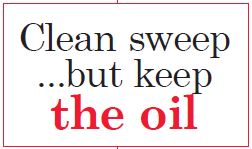 Every story has an origin. According to Manheim, PA homeowner Tim Slusser, the story of his “New” home’s massive makeover started with a puddle in the mechanical room. He and his wife had just purchased the mid-’70s bi-level. Two weeks later, the home had a new roof. Water that found its way inside had destroyed part of an exterior wall and part of the second story subfloor.
Every story has an origin. According to Manheim, PA homeowner Tim Slusser, the story of his “New” home’s massive makeover started with a puddle in the mechanical room. He and his wife had just purchased the mid-’70s bi-level. Two weeks later, the home had a new roof. Water that found its way inside had destroyed part of an exterior wall and part of the second story subfloor.
 Apparently, bees also took a shine to the little hole where the rain got in. The pest control pro apologized to the homeowners for the large, up-front fee saying, “The nest has been active for a while; it’s a big one.”
Apparently, bees also took a shine to the little hole where the rain got in. The pest control pro apologized to the homeowners for the large, up-front fee saying, “The nest has been active for a while; it’s a big one.”
Within several months, carpets that hid slicks of animal soiling, ‘70s-era bathrooms and mustard-yellow aluminum siding were all replaced to update the home.
Throughout the remodeling process, the Slussers wanted to boost the home’s energy efficiency. The attic, newly free of angry bees, had only four inches of fiberglass insulation. An additional 30 inches of blown-in Atti- Cat fiberglass made an immediate improvement. The block walls of the basement were covered in foam insulation, then pine tongue and groove. Several windows and doors were also replaced.
“At every turn,” added Slusser, “we heard cha-ching, cha-ching.” Money was moving into the home at a clip I’d never imagined.”
The last remaining project—a job Slusser knew he’d hire a team of professionals to handle —was to replace the home’s mechanical system. Although in good condition, the system was designed for a larger, less efficient home. After a heat load analysis, it was clear that the boiler was originally 30 percent larger than it needed to be.
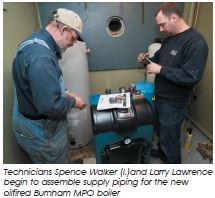 “We’ll, it was the last wad of bills to hit the bottom of our money pit,” complained Slusser. “We just couldn’t do the work we’d done on the house to see the last remaining task un-done. Clearly, the boiler was a lot bigger than it needed to be.”
“We’ll, it was the last wad of bills to hit the bottom of our money pit,” complained Slusser. “We just couldn’t do the work we’d done on the house to see the last remaining task un-done. Clearly, the boiler was a lot bigger than it needed to be.”
Oversized much?
The home’s original mechanical equipment had been replaced in 2006 with a boiler of equal size. A 180 MBH, oil-fired New Yorker boiler with an internal DHW coil provided all the heating needs . . . and then some.
“A manual-J heat load calculation at the 2,200 square-foot home resulted in a 48,000 Btuh heat loss, with an outdoor temp of 10°F and an indoor temp of 70°F,” said Dave Yates, owner York, PA-based F.W. Behler, Inc., hired by Slusser to perform the retrofit.
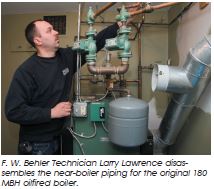 “Using Taco’s FloPro Designer software, I learned quickly that the New Yorker was rated for an output nearly three times what the house needed,” explained Yates. The boiler was oversized and short-cycling.
“Using Taco’s FloPro Designer software, I learned quickly that the New Yorker was rated for an output nearly three times what the house needed,” explained Yates. The boiler was oversized and short-cycling.
“The boiler must’ve been sized by the ‘curb’ method, from a block or two away,” added Yates with a grin. So, in early 2012, with oil prices hiking, it was time to downsize.
The bees and the big boiler were both removed. An old water softener and wholehouse UV light—both of which were well past their prime—were removed. Groundwater in southern PA often contains coliform bacteria, high nitrate levels and moderate amounts of scale, so the equipment was ready to go.
Honey, I shrunk the boiler!
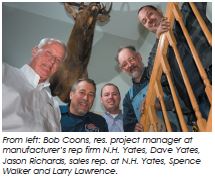 The system Yates chose includes a 64,000 Btuh Burnham MPO-IQ boiler with Beckett Burner and a 75 gallon Bradford White indirect water heater with on-board electronic anode and thermostatic scald-guard valve to ensure both longevity and bather protection. “We’ve installed Bradford White equipment for years and have never been disappointed.”
The system Yates chose includes a 64,000 Btuh Burnham MPO-IQ boiler with Beckett Burner and a 75 gallon Bradford White indirect water heater with on-board electronic anode and thermostatic scald-guard valve to ensure both longevity and bather protection. “We’ve installed Bradford White equipment for years and have never been disappointed.”
Technicians Larry Lawrence and Spence Walker carefully laid out all the mechanical components before lighting a torch. The seven-by-eight-foot area wouldn’t leave room for error. “We had to conserve space on this job,” said Yates. Yates built his parts list carefully. One of the first, new-generation ECM circulators from Taco—the yellow and black, variable speed BumbleBee—was ordered. “The Slussers removed a bunch of bees from the home months ago, but this was one they were eager for us to find a permanent place for,” quipped Yates.
 The ECM circulator provides flow to the upstairs and downstairs zones of the house. At each loop, the system uses a one-watt Taco Zone Sentry zone valve.
The ECM circulator provides flow to the upstairs and downstairs zones of the house. At each loop, the system uses a one-watt Taco Zone Sentry zone valve.
According to Yates, the Taco hydraulic separator, mounted directly above the boiler,
helps the home’s two heat zones and the Bradford White indirect “play well together.”
A 007 circulator is used as the main boiler pump, providing steady circulation within the short loop. Yates included a half-inch Watts RBFF (residential boiler fill fitting) to ensure the system stays full, and a Taco 4900 air and dirt separator to keep the fluid pure.
“The BumbleBee is a Delta-T circulator,” said Yates. “So it ramps up to full speed
momentarily until it finds the difference in supply and return temperature, then backs
down to the ideal flow rate for one or both of the zones.” A digital readout on the face
of the circulator flicks between readouts for GPM and electric consumption.
“On this job, it usually coasts along at sixand- a-half GPM, consuming only 9 watts,”
said Yates. Couple that with the two, onewatt Zone Sentry valves and we’re using
just 11 watts instead of 174 watts for two circulators! In fact, the ECV (Energy Conservation Value) is $58.73 in the first year, but when we look at a 20-year ECV with
an annual increase in cost for electricity, it shows a savings of $1,947.87.”
“I fully expect their home to use half, or less, of the heating-oil previously consumed while maintaining optimal comfort,” continued Yates. “And: reduced power-consumption.”
Shoe-horned in
“Access to the inside of a Burnham MPO is convenient,” said Yates. “The door, which is in the front of the boiler, just swings open.” To help overcome tight space constraints, the Bradford White indirect was placed to the left of the boiler so that the service door could swing in front of the tank. To the right of the boiler, the original Well-XTrol tank was pushed several inches from its previous position.
The homeowner didn’t want to expose all-new water fixtures to any scale, even if it meant using a dual tank system. So a twin-tank Watts water treatment system was installed; while one tank is recharging, the other conditions incoming water.
No reserve capacity is required to carry the tanks until a recharge can happen. There’s no possibility of the bypass valve opening while one tank recharges. The new Watts system can be used in a timer or metered configuration and when set to meter, will use
less salt than the previous, timer-only tank.
A new 12 GPM Watts whole-house UV disinfection system accompanies a media filter on the wall above the water softener. If power is lost to the house, a solenoid valve closes; no contaminated water slips by the UV light to re-seed freshly-sterilized domestic water.
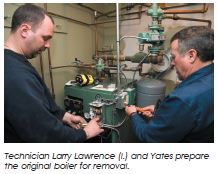 “The old UV light was a 7.5 GPM model,” said Yates. “I prefer a little more flow capacity to accommodate quick bursts and numerous fixtures running simultaneously.”
“The old UV light was a 7.5 GPM model,” said Yates. “I prefer a little more flow capacity to accommodate quick bursts and numerous fixtures running simultaneously.”
Aside from the MPO boiler’s inherent efficiency (Yates found 89.6 percent at the flue using an electronic combustion analyzer while adjusting the Beckett burner), it’s equipped with a compact, three-pass cast iron heat exchanger. The boiler also includes the optional IQ panel that allows the addition of features like outdoor reset, low water cutoff and auxiliary highlimit for additional protection, enhanced efficiency, and that complies with new 2012 government regulations.
The large-volume indirect tank helped to lengthen boiler run-time while, at the same time, reduce boiler size overa l l — i m p r o v i n g efficiency and promoting a clean burn
cycle.
Yates wanted a circulator with an internal flow check on the water heater, so he installed a Taco 00RIFC to tap the boiler. The three-speed circulator remains on low, letting supply water take it’s time through the big coil inside the tank.
Bradford White tanks can be ordered with a tempering valve on top of the tank so that water exits at safe temperatures. “We can store 140°F—or higher—water while the outgoing supply temp is only 120°F,” said Yates.
The removed New Yorker boiler had a six-inch flue, while the MPO required a four-inch pipe. After sealing up the new flue, Yates covered the oversized terracotta chimney liner with a polished diamond plate ring as a finishing touch.
“We’re glad that Bob Coons and Jason Richards from N.H. Yates [manufacturer’s representatives for Burnham and Taco based in Cockeysville, MD] were able to stop by on the day the boiler went in,” said Yates. “It was good to have quick access to product information.”
Reuse, reduce (oil consumption)
It would’ve been a shame to discard a healthy, sixyear-old boiler. The Slussers knew that the top of a scrap heap was no place for it. Months before Yates and his crew arrived, the
Slussers were visiting neighbors who lamented the fast approach of winter, voicing concerns about whether or not their old boiler would make it through another season.
The neighbors’ enormous coal-to-oil conversion drank 240 gallons a month at the height of the heating season. The old farmhouse needed an energy retrofit of its own—but at least they’d replaced all the old doors and windows.
While Yates was at the Slusser home taking measurements and completing the heat load calculation several weeks before the install, he visited the neighbor’s home at Slusser’s request. Twenty minutes later he confirmed the Slusser’s suspicion: “Yep, your boiler would be a good fit for their place.”
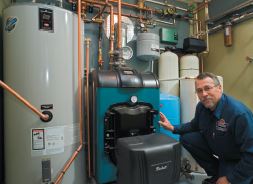 For a yard sale price, Slusser sold the boiler to his neighbor. Along with it, the neighbor received the expansion tank, isolation valves and some perfectly fine Taco 007s.
For a yard sale price, Slusser sold the boiler to his neighbor. Along with it, the neighbor received the expansion tank, isolation valves and some perfectly fine Taco 007s.
“We made a two-fer out of it,” said Slusser. “What started out as a nasty, money pit problem led to huge improvements here, and for our neighbors, too. We’re delighted with the way things turned out.”